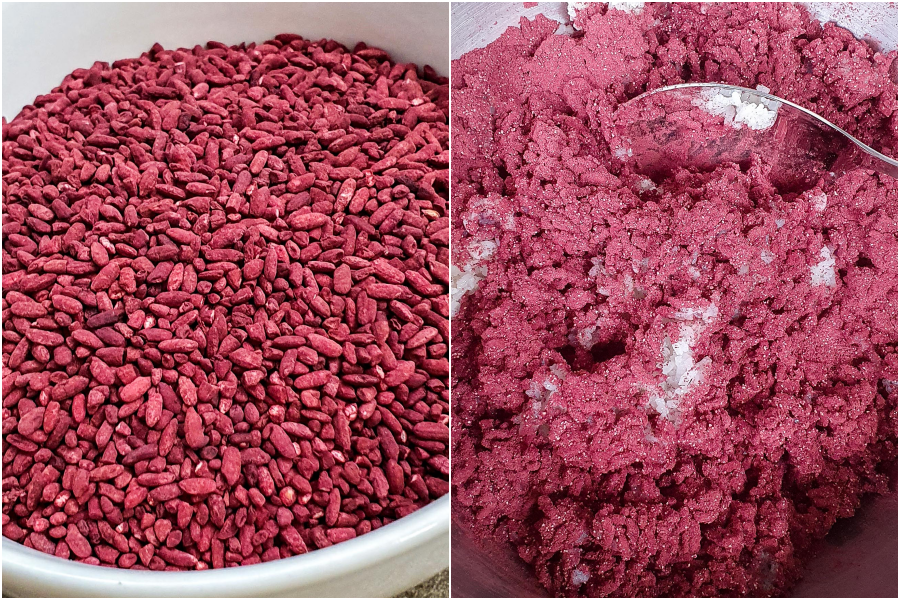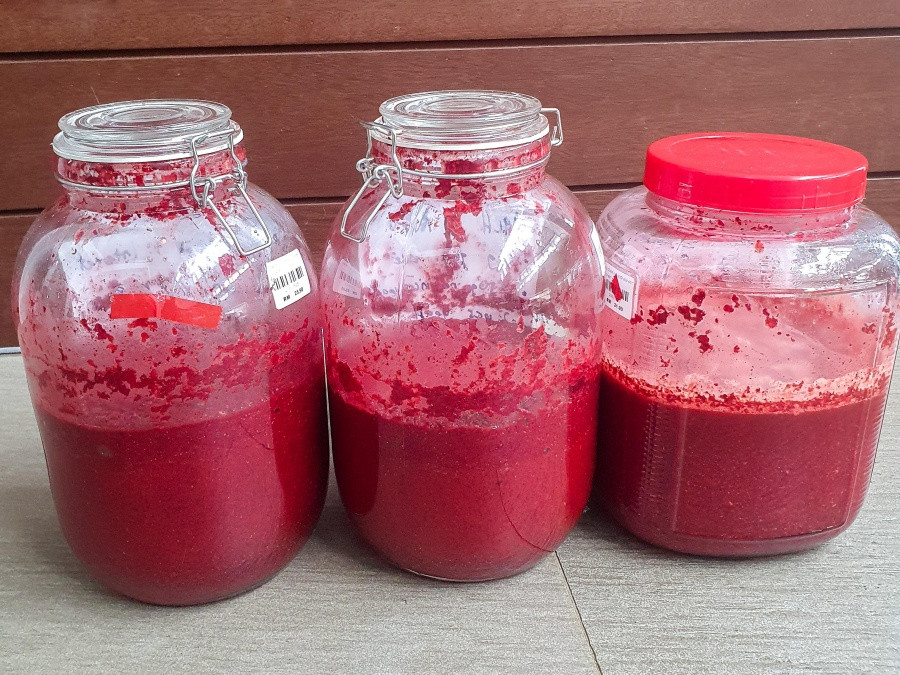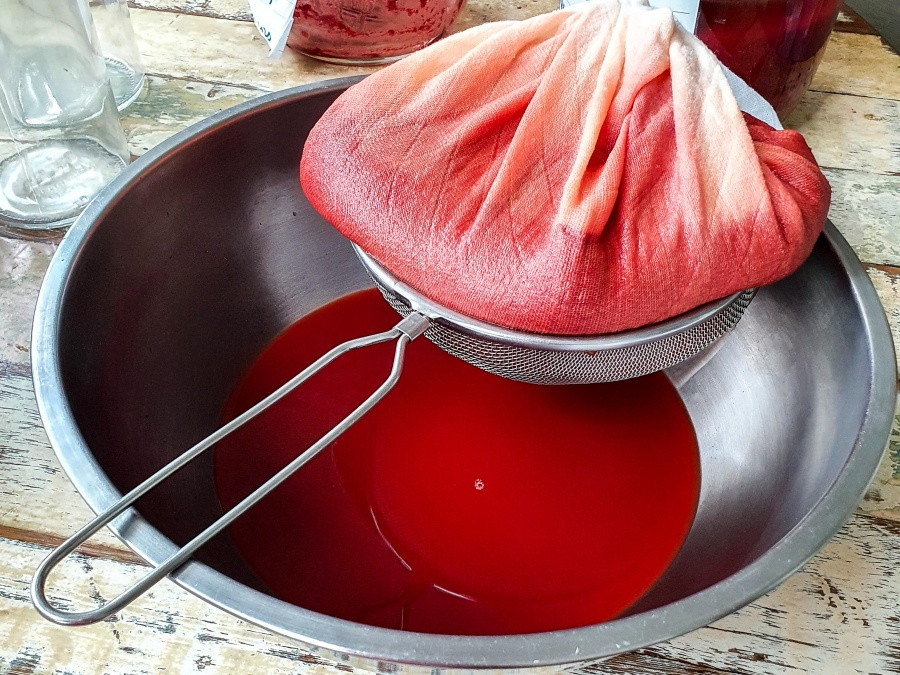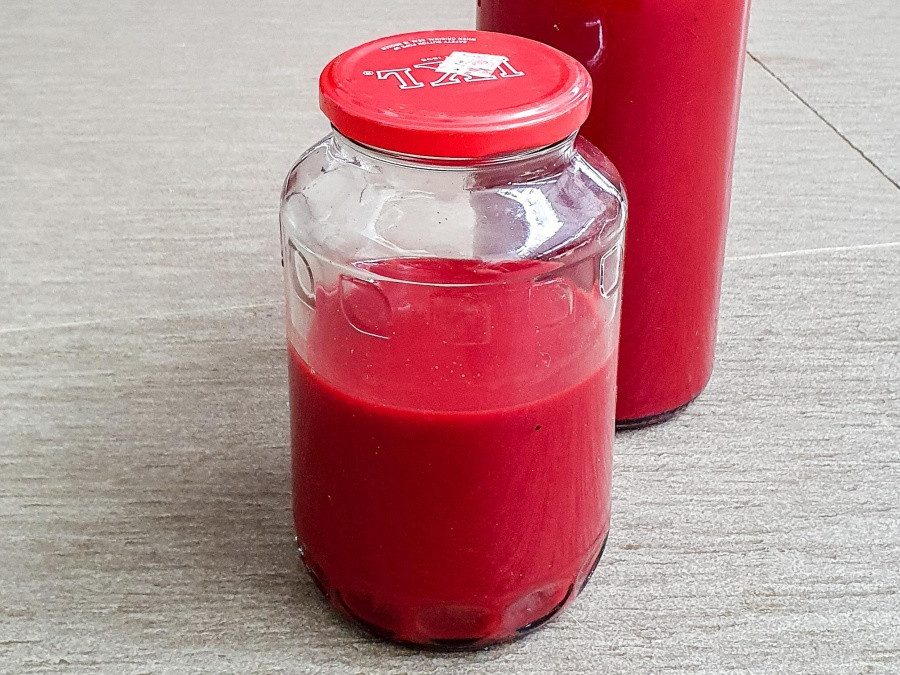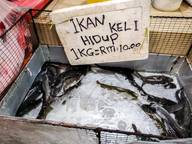The painstaking process of making Foochow red wine
by Mildred Voon05 Feb 2021
One home cook turns to her family recipes, the Internet, and a healthy dose of curiosity to make Foochow red yeast rice wine.
On the first day of Chinese New Year in my mother’s hometown in Sibu, Sarawak, before the stream of visitors and relatives arrive, the day begins with the fragrance of hearty chicken broth wafting in from the kitchen, buoyed by the fragrant sweet notes of Foochow red wine. For Foochows, breakfast on the first day is the most important meal of the year: the iconic mee sua. The silky noodles, served in a piping hot bowl of kampung chicken broth fortified with Foochow red wine, signify prosperity and a long, joyous life.
Foochow red wine, or red yeast rice wine, is a cooking wine with a sweet, fruity fragrance that is vital to Foochow cuisine. The wine is used to cook meats, seafood and even added as a finishing touch to some vegetable dishes. My second aunt has been making the wine for many years and is the main supplier of the wine for our extended family. Every visit to Sibu ends with the packing of homemade Fuzhou delicacies into boxes and luggages, including carefully wrapped bottles of wine, ready to be brought to our final destinations of Kuching, KL, Taiwan, and the US.
Red yeast rice wine has a history of more than 1,000 years, going back to the Song Dynasty (960-1279 AD) in China. The wine originates from the Fuzhou and Zhejiang provinces and continues to be a key feature in modern day Fuzhou cuisine. The first Chinese migrants from the Fuzhou province came to modern day Malaysia in the early 1900s, becoming known as the Foochow people, with two main settlements in Sitiawan, Perak and in Sibu, Sarawak. Along with their farming expertise, the Foochows brought their traditional cuisine to their new settlements.
Today, most Foochow families in Malaysia make their own red yeast rice wine, or buy bottles of the wine from markets or neighbourhood ah sohs (aunties). The red wine is integral to mee sua, a key feature at any Foochow celebration of life and new beginnings whether it’s new year, weddings, the birthday and birth month of a baby, and all the subsequent birthdays of a Foochow person. The wine is also a must-have in chicken soups during the confinement period for Foochow mothers, said to assist in the replenishment of nutrients and energy.
Tradition, taboo, and lots of patience
Each Foochow family has a slightly different recipe for making red yeast rice wine. The variation is in the ratio of red yeast rice (hóng qǔ mi, 红麯米) to cooked glutinous rice, as well as the inclusion (or exclusion) of wine yeast and filtered water. Some recipes even call for the addition of Chinese white wine at the final stage of the 30- to 60-day fermentation stage, to sweeten the wine further. And as with any traditional family secrets, there is also a list of taboos when making the wine. Women who are menstruating are not allowed to take part in the winemaking, or even be in contact with the wine jars while the fermentation process is on-going, for fear of contaminating the wine. Some families also keep the wine hidden from view until the final product is ready.
The most important ingredient in the wine is red yeast rice, which is rice fermented with a red mould called the Monascus purpureus. Red yeast rice is a traditional medicinal ingredient, most famously found in the Sibu Foochow origins of Gutian in Fuzhou, China and used to improve digestive and heart health. In more recent years, red yeast rice has gained popularity worldwide as a supplement to lower cholesterol levels.
The red yeast rice wine also has a very important by-product: the lees, yeast sediments leftover from the wine-making process. In the Foochow language, it is known as ang zhau, and has a deep umami flavour with a soft, grainy texture, almost like a bumpy, soft cheese spread. It is a crucial ingredient in Fuzhou cuisine, used to cook meat stews, vegetables, noodles and even as a filling for snacks. Ang zhau is also recorded in a historical collection of Chinese remedies and medication, The Compendium of Materia Medica published in 1598, in a recipe for cooking lamb and goat.
My aunt’s recipe for red yeast rice wine is one of the more purist versions as she uses only three ingredients: glutinous rice, red yeast rice, and water. The recipe is simple, but the task of wine-making is one that takes great patience and care. The process starts with sterilising all the equipment needed—including glass storage jars—with boiling water, and then ensuring that everything is completely air-dried under the sun.
Glutinous rice is cooked in a rice cooker the night before, and spread out in trays to cool off. The next day, red yeast rice is ground in a food processor and carefully mixed and massaged into the cooled, sticky glutinous rice. The mixture is added into glass jars, combined with filtered water, stirred vigorously, covered and stored in a cool, dark place. For the next five days, my aunt would stir the mixture twice a day, once in the morning and again in the evening. On the second day, the fermentation process begins, and as the bubbles start rising to the surface you can smell hints of sweetness in the mixture. At the end of the last stir on the fifth day, my aunt seals the jar and leaves it for 55 days.
After much patience and a total of 60 days, the wine is ready to be harvested. There is a clear separation between the wine and the ang zhau sediments at the bottom. The mixture is poured into a basin through a muslin cloth, and the ang zhau is squeezed to filter out the precious red yeast rice wine. The wine is kept in sterilised glass bottles and the ang zhau stored in the fridge.
Trying my hand at wine-making
In my extended Foochow family, my three aunts are the only ones who know how to make the wine. Prior to this year, I had assumed that they had learnt the art from my grandmother, only to find out that even my late grandmother was unsuccessful in making the wine. The wine-making process is tricky, as any contamination can cause the wine to go sour or develop mould, spoiling the whole batch.
In my pursuit of learning more about Foochow cuisine, I decided to make my own wine and experiment with different recipes. My initial plans to be my aunt’s cooking apprentice for a month were foiled by the Covid-19 pandemic, so I resorted to a series of phone calls and WeChat voice notes with my aunts in Sibu and Miri. I wrote down notes and pointers, read blogs and watched YouTube videos extensively, and even consulted a fellow Foochow friend who had successfully made the wine while studying in the US.
I made four batches of wine, which I tucked away in a dark corner of my family’s storeroom: Jar 1 (“The Internet”, red yeast rice to glutinous rice ratio of 1:10 with white yeast chips, no water, fermented for 40 days), Jar 2 (“Ngu” ratio 1:4 ratio with white yeast chips, no water, fermented for 60 days), Jar 3 and Jar 4 (“My aunt’s recipe” – ratio 1:4, with 375ml filtered water, fermented for 60 days). Two weeks into the process, I suffered the fate of many disappointed Foochows before me as Jar 3 was plagued with a thick layer of clear mould with white spots, resulting in a potent smell of a strong liquor, similar to vodka. It had to be discarded, and I quickly made Jar 4 as a replacement.
After weeks of “Are your wines ready yet?” from my family, the wines were ready to be harvested and tasted. “The Internet” was not quite the full-bodied red wine I expected. The aroma was sweet, compared to the stock of wine we have in the kitchen, but it had a mild, almost timid level of alcohol. “Ngu”, my friend’s family recipe, was the clear winner. It had the sweetest, most fruity (almost pear-like) flavour of the three wines, leaving a deep, lingering richness on the tongue. “My aunt’s recipe”, which did not contain white yeast chips, was not as sweet, and it delivered the strongest punch of alcohol, with a hint of sourness common to Foochow red wines.
My wines are ready just in time for Chinese New Year—and though it will be a strange year not being able to travel back to our hometown, I’m going the extra mile to make sure that our mini-celebration in Kuching will be just as festive. I’m currently working out the details of a full three-day menu—filled with food we would usually eat in Sibu, starting with, most importantly, mee sua on the first day made with the best of my very own, homemade Foochow red wine.
**
Mildred Voon is on a quest to master traditional Foochow and local Sarawakian recipes from her shared family kitchen in Kuching.
Read next
How my grandfather wooed his son-in-law—with peanut cake
A rare Foochow delicacy—made to impress

Does ammonium bicarbonate make a better char siu bao?
Raising a stink

The science and joys of making pekasam
An earthy and earthly delight


